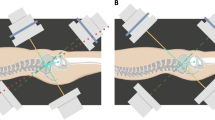Abstract
The clinical efficacy was compared between 3D navigation-assisted percutaneous iliosacral screw (3DPS) and minimally invasive reconstruction plate (MIRP) in treating sacroiliac complex injury and the surgical procedures of 3DPS were introduced. A retrospective analysis was performed on 49 patients with sacroiliac complex injury from March 2013 to May 2017. Twenty-one cases were treated by 3DPS, and 28 cases by MIRP. Intraoperative indexes as operative time, blood loss, incision length, length of hospital stay and postoperative complications were respectively documented. Quality of reduction was postoperatively evaluated by Matta radiological criteria, and clinical effect was assessed by Majeed scoring criteria at the last follow-up. Operative time and hospital stay were significantly shortened, and blood loss, and incision length were significantly reduced in 3DPS group as compared with those in MIRP group (P<0.05). No statistically significant difference was found between 3DPS group and MIRP group in the assessment of reduction and function (P>0.05). It was concluded that both 3DPS and MIRP can effectively treat the sacroiliac complex injury, and 3DPS can provide an accurate, safe and minimally invasive fixation with shorter operative time and hospital stay.
Similar content being viewed by others
References
Zhang CM, Liu HY, Zhu Z, et al. Effectiveness of percutaneous iliosacral screwing versus reconstruction plating for treatment of pelvic posterior ring fractures of Tile C: a Meta analysis. Chin J Orthop Trauma (Chinese), 2017,9(6):476–483
Acklin YP, Marco G, Sommer C. Double locking plate fixation of sacral fractures in unstable pelvic ring C–type injuries. Oper Orthop Traumatol, 2015,27(1):74–79
Iorio JA, Jakoi AM, Rehman S. Percutaneous Sacroiliac Screw Fixation of the Posterior Pelvic Ring. Orthop Clin North Am, 2015,46(4):511–521
Tlie M, Helfet DL, Kellam JF, et al. Comprehensive classification of fractures in the pelvis and acetabulum. Berne, Switzerland: Maurice. Muller Foundation, 1995
Morel–Lavallée M. Decollements traumatiques de la peauet descouches sous–jacentes. Arch Gen Med, 1863,1(4):20–38
Tan ZK, Chen ZH, Cai XH, et al. A prospective study of revised injury severity score in 2260 cases of trauma. J Orthop Trauma, 2007,9(3):236–238
Matta JM, Tornetta P. Internal fixation of unstable pelvic ring injuries. Clin Orthop Relat Res, 1996,8(329):129–140
Majeed SA. Grading the outcome of pelvic fractures. J Bone Joint Surg Br, 1989,71(2):304–306
Zhang J, Xie F. Application of damage control theory in the treatment of elderly unstable pelvic fractures. J Trauma Surg, 2016,18(6):346–349
Liuzza F, Silluzio N. Comparison between posterior sacral plate stabilization versus minimally invasive transiliac–transsacral lag–screw fixation in fractures of sacrum: a single–centre experience. Int Orthop, 2018,42(10):2459–2466
Suzuki T, Hak DJ, Ziran BH, et al. Outcome and complications of posterior transiliac plating for vertically unstable sacral fractures. Injury, 2009,40(4):405–409
Bousbaa H, Ouahidi M, Louaste J, et al. Percutaneous iliosacral screw fixation in unstable pelvic fractures. Pan Afr Med J, 2017,27:244
Khaled SA, Soliman O, Wahed MA. Functional outcome of unstable pelvic ring injuries after iliosacral screw fixation: single versus two screw fixation. Eur J Trauma Emerg Surg, 2015,41(4):387–392
Charles YP. Sacroiliac joint luxation after pedicle subtraction osteotomy: report of two cases and analysis of failure mechanism. Eur Spine J, 2016,25(1):63–74
König MA, Hediger S, Schmitt JW, et al. In–screw cement augmentation for iliosacral screw fixation in posterior ring pathologies with insufficient bone stock. Eur J Trauma Emerg Surg, 2018,44(2):203–210
Grechenig S, Gänsslen A, Gueorguiev B, et al. PMMAaugmented SI screw: a biomechanical analysis of stiffness and pull–out force in a matched paired human cadaveric model. Injury, 2015,46(4):125–128
Kim JW, Quispe JC, Hao J, et al. Fluoroscopic Views for a More Accurate Placement of Iliosacral Screws: An Experimental Study. J Orthop Trauma, 2016,30(1):34–40
Eastman JG, Routt ML Jr. Correlating preoperative imaging with intraoperative fluoroscopy in iliosacral screw placement. J Orthop Traumatol, 2015,16(4):309–316
Mcandrew CM, Merriman DJ, Gardner MJ, et al. Standardized Posterior Pelvic Imaging: Use of CT Inlet and CT Outlet for Evaluation and Management of Pelvic Ring Injuries. J Orthop Trauma, 2014,28(12):665–673
Amiot LP, Lang K, Putizer M, et al. Comparative results between conventional and computer–assisted pedicle screw installation in the thoracic, lumbar, and sacral spine. Spine, 2000,25(5):606–614
Peters P, Langlotz F, Nolte LP. Computer assisted screw insertion real 3D rapid prototyping pelvis models. Clin Biomech (Bristol, Avon), 2002,17(5):376–382
Wang XZ, Meng CF, Wang GD, et al. Three–dimensional navigation technology for placement of percutaneous sacroiliac joint screw internal fixation in treatment of sacroiliac complex injury. Chin J Orthop Trauma, 2016,11(18):921–926
Sawkar AA, Swischuk LE, Jadhav SP. Morel–Lavallee Seroma: A Review of Two Cases in the Lumbar Region in the Adolescent. Emerg Radiol, 2011,18(6):495–498
Author information
Authors and Affiliations
Corresponding authors
Rights and permissions
About this article
Cite this article
Lu, Ql., Zhu, Yl., Li, Xg. et al. Comparison of Efficacy between 3D Navigation-Assisted Percutaneous Iliosacral Screw and Minimally Invasive Reconstruction Plate in Treating Sacroiliac Complex Injury. CURR MED SCI 39, 81–87 (2019). https://doi.org/10.1007/s11596-019-2003-9
Received:
Revised:
Published:
Issue Date:
DOI: https://doi.org/10.1007/s11596-019-2003-9




